Water, one of the crucial elements of life, can be characterized by several aspects such as visual, psychological, and physical.
It has permanently established links between culture, nature, organic, and inorganic lives.
In different eras of history, rivers have played significant roles in flourishing civilizations like the Indus valley civilization that prospered near the Yamuna riverbank, the Mesopotamian civilization on the Tigris and Euphrates river banks, and the Nile valley civilization on the shores of the Nile river.
Plenty of civilizations came into existence with time progression and faded away at the same instance.
However, the monuments, inscriptions, or submerged underwater buildings whose remains are still found by archaeologists.
The underwater sculpture park in Molinere, Dwarka in India, the Yonaguni Monument in Japan are some of the most mysterious underwater structures in the world.
The top 10 most puzzling submerged structures are listed below with details:
Which is the oldest underwater building?
Content
Pavlopetri is the oldest sunken city globally, dating back to 5000 years old in Greece.
Where is the lost Atlantis city?
The lost Atlantis city is estimated to be underwater in southern Spain that was swept away by a massive tsunami.
Which technology is used to find underwater structures?
A sonar device is used to map the ocean ridges underwater and record the sound echoes of underwater structures.
10. The Yonaguni monument in Japan

The Yonaguni monument, also known as Yonaguni submarine ruins, is an ancient Japanese underwater rock arrangement about a hundred kilometers east of Taiwan.
Many believed it was a ziggurat structure belonging to some ancient civilizations, while others thought it to have been created naturally.
Yonaguni was discovered by a diver in 1987, around twenty-five meters underwater on Japanese Ryukyu island consisting of perfectly carved steps with straight edges.
It was contemplated as the ruins of Japanese Atlantis, a primordial city that drowned due to an earthquake about 2000 years ago.
After multiple site observations, a Japanese geologist was convinced that the Yonaguni was a 5000 years old monument.
It has Pyramid-shaped steps with carvings on the stones suggesting it to be the remains of an ancient city.
The rectangular stacked pyramid-like structure with the narrow passage and arched entrances was found attached to a giant rock, so some geologists claim it to have been natural.
In contrast, evidence like marks from tools, retentive walls, drainage canals, roads, and carved turtle monuments pointed out that Yonaguni is an artificial monolith.
In addition to it, the surrounding areas consisted of a series of smaller temples, possibly a stadium and roads to connect all of them, monumental inscriptions carved with animals.
Despite many controversial theories, the debate over Yonaguni being a cultural landmark or a natural landmark has never been resolved.
9. Shi Cheng in China
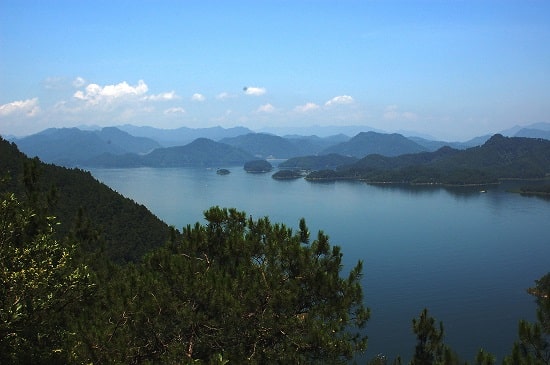
Shi Cheng is a Chinese underwater stone architecture representing the remains of the Lion City.
It was found under lake Qiandao as the city was drowned on purpose by the Chinese government during the 1960s to construct a hydroelectric dam.
Shi Cheng was estimated to be 1300 years old, lying 40 meters beneath the water level, built during the Eastern Han dynasty.
It was first set up in 208 A.D., lying on the foothills of mountain Wu Shi that was rediscovered in 2001 A.D. when the Chinese government arranged an expedition for the remnants of the lost county.
The city was drowned under Qiandao lake, also known as the thousands of Island lakes, as plenty of islands lie within the lake, which was artificial to create space from a dam.
Around 3000 residents were shifted elsewhere from the lion city that was once the central hub for politics, economics, and cultural aspects.
Flooding aided in protecting the city from the scorching sun and wind damage.
As per the visual reports of the restoration campaign, the city had five major entrance portals with six rods that connected each corner of the city.
Furthermore, roads in lion city were stone-paved with flagstones and cobblestones wide enough to have 265 archways.
It preserved stoneworks of lions, dragons, phoenixes, and several other ancient engravings dating back to the 1780s.
Shi Cheng has been limited to a few divers with expertise in night diving and buoyancy in deep water.
8. Dwarka, India
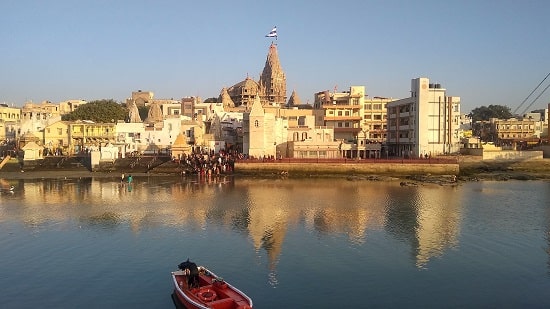
The legendary city of Dwarka was founded by Lord Krishna, a Hindu deity in Gujarat of present-day India that has validation to the epic Mahabharat and the Bhagwat Geeta.
As per Hindu scripts, after Shri Krishna left the mortal world and left for the spiritual world, his city submerged into the sea, whose excavation began only in the 1930s.
Underwater excavation of Dwarka led to the finding of numerous artifacts and the city’s remains.
An archeologist discovered a fortified foundation upon which the primordial city walls were built along the shore of river Gomti.
Likewise, blocks of stones meant for erecting pillars in irrigation canals and some lustrous red pottery items were found by the Marine archeological unit in India.
Dwarka refers to the “door” in Sanskrit, eventually leading to Dwarka’s estimation as a doorway of trade between India and Arabic areas during the Middle Ages.
The remains found underwater were rectangular, semi-circular, and square stone structures ranging from intertidal sizes to 6 meters.
Dwarka was thought to have stone anchors, ridges-like features, a stone-built jetty, triangular stone anchors punched with three holes.
The deductions made after the marine survey indicated coastal erosion to be one of the primary reasons for the city’s destruction.
These remains have signified the presence of Krishna and his heroic figures to be accurate, not just merely being a folktale.
7. Underwater city near Cuba
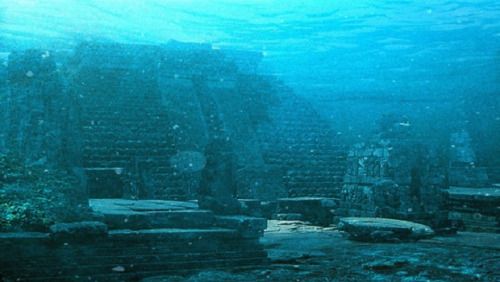
The underwater city of Cuba was discovered a decade ago on the western coast of Cuba after sonar equipment picked up a series of stone structures around 650 meters below water level.
Divers came across circular columns of stone-paved analogous structures lying symmetrically along the barren desert of the ocean floor.
It represents the reminiscent of some ancient civilizations based in Cuba.
The urban complex covered an average of two square kilometers of area, recorded first in 2001 A.D. by marine engineer Pauline Zalitzki with coordination with the Cuban government.
Several pyramids and circular structures made out of massive blocks of smooth stones were observed underwater.
In addition to it, the smooth stones resembled hewn granite, deducing the fact that it had taken almost 5000 years for the city to sink.
None of the civilizations existing in that era could construct such complex infrastructures.
The peculiar structures had an estimated dimension of 8 feet by 10 feet. They resembled a local culture that may have linked the Mexican Peninsula with Cuba, relating it to the Mayans and the native Yucateco.
Despite the arousal of hundreds of theories regarding the city’s origins, a significant obstacle lies behind the incredible depth it is situated, indicating it to have existed during the Ice age.
However, no relevant culture or biological evidence has been found yet.
6. Port Royal in Jamaica
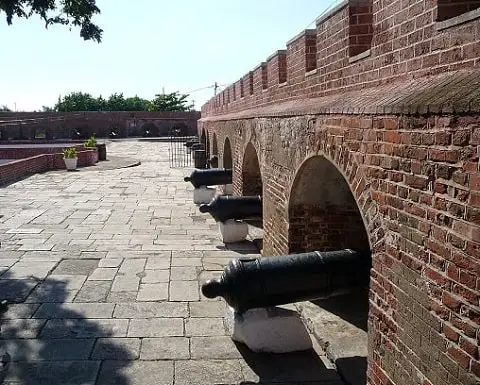
The Port Royal of Jamaica was renowned as one of the most wicked cities globally due to its links with pirates, lootings, destructions, and ferocious naval conquests.
It submerged after the earthquake on June 7, 1692, causing two-thirds of the city to be drowned.
Port Royal was finely preserved in the waters just like it was on the earthquake day, unlike any other historical site that underwent construction, renovation, abandonment, and collapse.
It was situated on an 18 miles long sandpit 15 miles from the Jamaican capital, surrounded by water bodies.
Excavation campaigns started later in the 1960s that found shards of pottery, stone metate used for grain grinding dating back to 1000 A.D.
The city was famous for the slave trade, sex workers, pirates, fishing camps, and the hub of English life in Jamaica.
After the earthquake, nearly 33 acres of land slipped underwater, with 2000 death casualties destroying around forts in the town.
The submerged buildings provide light on the lives of people in the 17 th century A.D. with remains of fish markets, earthbound briskly built pillars, three ships, taverns, and meat markets.
Simultaneously, multi-storied brick buildings 53 feet wide and 47 feets deep serving as living quarters, peripheral walls were also discovered during the marine expedition.
The government restricts diving into the Port Royal region in Jamaica without its consent.
5. Stonehenge in Lake Michigan

The Stonehenge in lake Michigan was accidentally found while archeologists were looking after sunken shipwrecks in 2007.
A circular stone structure was discovered that contained prehistoric carvings of mastodon and a series of Stonehenge, unlike the megalith land Stonehenge.
Scientists had used remote sensing sonar techniques to expose the boulders about 60 feet beneath the water level in Lake Michigan. It was about 4 feet high and 5 feet long, with several fissures on the surface.
The discovery was made by a professor of underwater archeology at Northwestern University, Marc Holly, and his colleague Brian Abbott in 2007.
They believed that Stonehenge could date back to 9000 years ago with one of the stones carrying mastodon’s inscriptions, which existed 10,000 years ago.
It was argued that the stones must have been laid symmetrically during the Ice Age when the lake bed was probably dry.
4. The Mound in the sea of Galilee
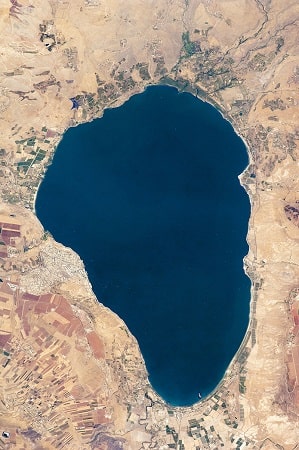
Archeologists found a puzzling stone structure with an extraordinary diameter of 9 meters underneath the sea of Galilee in Israel.
It was also accidentally found while using sonar technology for underwater explorations at the bottom of the lake in 2003 A.D.
A gigantic cone-shaped monument made up of unhewn basalt pebbles weighed around 60,000 tons heavier than modern-day warships.
As per the studies, the shape and composition of the boulder do not have links with natural build-up; hence it was deduced to be man-made.
The megalithic structure must have been planned to be built on the land by the people of an ancient city named Bet Yeah.
However, the rise in sea level might have drowned it. In addition, divers have mentioned that the rock has no signs of cutting or chiseling with natural faces.
Some researchers have claimed it to be 4000 years old as evidence of such giant megalithic stone works during the 3rd millennium B.C.E. Standing 32 feet high.
The structure might have also been placed for the fish nursery, yet the exact shape of the rock has been difficult to decipher.
The murky water in the sea also contributed to adding obstacles to proper studies of the structure.
3. Bimini structures

The Bimini Road is the underwater roadway in North Bimini island of Bahamas, also referred to as Bimini walls.
As per Greek mythology, the city of Atlantis drowned under the water in a single day, under which the Bimini roads lie.
In 1968, a diver on the coasts of North Bimini Island discovered a series of evenly spaced artificial stone structures lying 18 feet below the surface of water level.
The road-like line stretched about half a mile claimed to be a portion of the wall that previously belonged to a more significant part of the city.
The 8 kilometers long road contains northeastern, southwestern linear characteristics of roughly rectangular limestone blocks.
The Bimini walls consist of sub-rectangular or irregular blocks of a series of stones of varying thickness.
The larger blocks have complementary edges, smaller ones containing shorter and narrower linear features.
Block incorporated into the making of the roads resembled bread loaves made out of limestone known as the Beachrock, whose width was significantly reduced due to various physical, biological, and chemical weathering underneath the water.
During the initial days of inspection of the Bimini structures, divers described it as a pavement; however, after detailed studies, it was concluded to have been a series of smaller pebbles assembled in a linear progression.
Although some speculations revolve around the road being connected to Atlantis, the presence of limestones made it challenging to trace the origins of the Bimini roads.
2. Pavlopetri

Pavlopetri was the oldest sunken city globally that was discovered in 2011 after the inspection led by the B.B.C. using laser techniques for artifact evaluation.
It is located at the islet between Pavlopetri and the Pounta coast of Laconia near the Mediterranean sea.
The city contained remains dating back to the Neolithic and the Bronze age between 3000-1000 B.C.E. showcasing the lifestyles of prehistoric people.
Interestingly, the shallow water that submerged an entire city remained a mystery to the geologists.
The name suggests Paul’s Stone linking St. Paul and St. Peter, two renowned Christain apostles and the martyrs of the first century B.C.E.
From the elements obtained from the excavation of the region, scientists deduced that Pavlopetri was inhabited in 2800 B.C.
Buildings having chambers, courtyards, streets, tombs, and at least thirty-seven tombs and the archeological remains of walls were identified in Pavlopetri.
Likewise, bronze-aged potteries, chert blades, and obsidian were found on the sea bed.
Around 30,000 squares previously known along with an added 9000 square meters of new buildings, ceramics were traced from the left-overs of the Greek city.
The city was considered the critical center of the textile industry due to loom weights in the site that was drowned, possibly due to an earthquake in 375 B.C.
1. City of Heracleion in Egypt
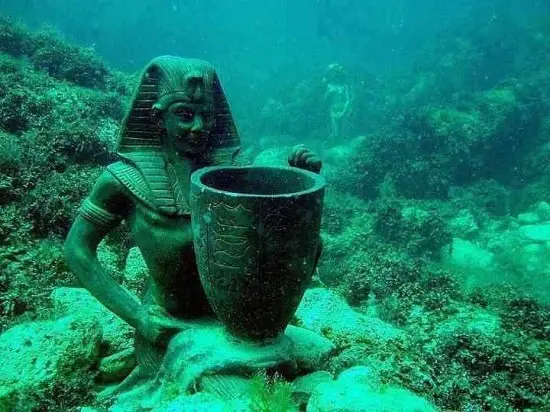
The lost city of Heracleion of Egypt was one of the largest Mediterranean ports before the discovery of Alexandria by Alexander the Great in 331 B.C.E.
After multiple scanning of Abu Qir Bay along the Egyptian coast, the lost underwater city was found.
It was submerged 6.5 kilometers below sea level on the Alexandrian coast, where around 64 ships, anchors, treasures of gold coins, and the remains of the massive temple of the god Amun-Geren were retained.
Tiny animals that were brought for the offering to be made to God Amun-Green were found in the city’s ruins.
Likewise, the most notable artifacts were made out of granite and diorite, giving glimpses of lives before 2500 years ago.
The ancient Greek city must have drowned after severe flooding, becoming the only city known by its Greek and Egyptian names.
The buildings were built with a crisscrossed network of canals with plenty of anchors and harbors.
Another idea suggested that even an earthquake may have caused the city’s drowning as after soil analysis, it was found that the site suffered liquefaction of soil.
As a result, the pressure exerted by large buildings might have compressed the region’s soil.
The wharves, beautifully carved temples, and high elevation tower houses were linked with bridges, pontoons, and ferries as the city was a prominent center for trade.
Conclusion
The mysterious underwater buildings and monuments like Stonehenge of lake Michigan, Bimini roads, the mound in the sea of Galilee were ancient lost structures rediscovered through comprehensive span laser inspection.
These structures demonstrated people’s lifestyles dating back to primordial times after excavating remains and artifacts from the site geologists and archeologists.
Ruins of the submerged structures included stones, pebbles, paved roads made out of granite, limestones, potteries, stele, ceramics, defensive walls, and the inscription carved on the surface of the monuments.
Today, such monuments are being preserved by several heritage conservation organizations in association with the respective governments of the sites from where these structures were discovered.
